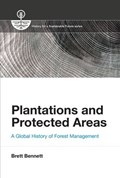How global forest management shifted from an integrated conservation model to a bifurcated system of timber plantations and protected areas.
Today, the world's forests are threatened by global warming, growing demand for wood products, and increasing pressure to clear tropical forests for agricultural use. Economic globalization has enabled Western corporations to export timber processing jobs and import cheap wood products from developing countries. Timber plantations of exotic, fast-growing species supply an ever-larger amount of the world's wood. In response, many countries have established forest areas protected from development. In this book, Brett Bennett views today's forestry issues from a historical perspective. The separation of wood production from the protection of forests, he shows, stems from entangled environmental, social, political, and economic factors. This divergence—driven by the concomitant intensification of production and creation of vast protected areas—is reshaping forest management systems both public and private.
Bennett shows that plantations and protected areas evolved from, and then undermined, an earlier integrated forest management system that sought both to produce timber and to conserve the environment. He describes the development of the science and profession of forestry in eighteenth- and nineteenth-century Europe; discusses the twentieth-century creation of timber plantations in the Americas, Asia, Africa, and Australia; and examines the controversies over deforestation that led to the establishment of protected areas. Bennett argues that the problems associated with the bifurcation of forest management—including the loss of forestry knowledge necessary to manage large ecosystems for diverse purposes—suggest that a more integrated model would be preferable.

